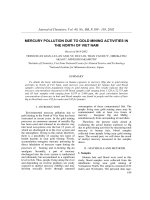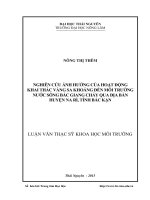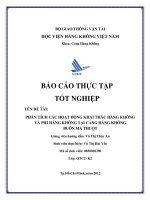Ô nhiễm thủy ngân do các hoạt động khai thác vàng ở Bắc Việt Nam
Bạn đang xem bản rút gọn của tài liệu. Xem và tải ngay bản đầy đủ của tài liệu tại đây (68.08 KB, 5 trang )
189
Journal of Chemistry, Vol. 40, No. DB, P.189 - 193, 2002
Mercury pollution due to gold mining activities in
the North of Viet Nam
Received 06-8-2002
Trinh Xuan Gian, Le Lan Anh, Vu Duc Loi, Tran Van Huy
1
, Hirokatsu
Akagy
2
, Mineshi Sakamoto
2
1
Institute of Chemistry, Viet Nam National Center for Natural Science and Technology
2
National Institute for Minamata dissease, Japan
Summary
To obtain the basic information on human exposure to mercury (Hg) due to gold mining
activities in North of Viet Nam, total mercury was determined for human hair and blood
samples collected from population living in gold mining area. The results indicate that the
mercury concentrations measured in 98 blood samples with ranging from 1.128 to 22.751 ppb
and 65 hair samples with ranging from 0.379 to 2.440 ppm, the good correlation between
concentration of mercury in hair and blood samples was found in people and the ratios of hair
Hg to blood hair were 195 for males and 142 for females
I - Introduction
Environmental mercury pollution due to
gold mining in the North of Viet Nam has been
concerned in recent years. In the gold mining
processes an enormous amount of metallic Hg
has been used and released in an abusive way
into local ecosystems over the last 15 years, of
which are discharged in to the river system and
the atmosphere. Owing to this metal, therefore,
there is a possibility of causing two types of
health hazards in near gold mining: Firstly,
accumulation inorganic mercury poisoning by
direct inhalation of mercury vapor during the
processes of burning and re-burning Hg-Au
amalgam. Secondly, a part of mercury
discharged into the river system is methylated
and ultimately bio-accumulated to a significant
level in fish. Thus, people living along the river
and depending on riverine products are easily
exposed to methyl mercury (MeHg) and may
develop toxically levels through repeated
consumption of these contaminated fish. The
people living near gold mining areas may be
contaiminated with at least two forms of
mercury - Inorganic Hg and MeHg -
simultaneously from surrounding air and diets.
Therefore, the present study aimed at
evaluating the actual human exposure to Hg
due to gold mining activities by measuring total
mercury in human hair, blood samples
collected from people living near gold mining
areas. The second past, we will show the result
of methyl mercury measured in the samples
above.
II - Materials and methods
1. Samples
Human hair and blood were used in this
study, blood samples were collected from the
inhabitants living near gold mining of
Vietnamese North. The subjects consisted of 82
males and 16 females. The personal data (age,
190
sex, address and occupation) were obtained at
the time of sampling.
2. Analytical procedures for mercury
In the present work, the determination of
total mercury was made with sensitive and
reliable methods recently developed in National
institute for Minamata disease (H. Agaki et al
2001)
Total mercury analysis in hair samples: The
procedure for total mercury in hair is shown in
figure 1. A known amount of 10 mg hair
sample was placed in a 50 ml volumetric flask,
to which 1 ml of water, 2 ml concentrated
sulfuric acid were added and heated at 200
o
C
on a hotplate for 30 min. After cooling until the
room temperature, the digested sample was
made up to 50 ml with mercury-free water. An
aliquot of sample solution was introduced into
an automated circulating air flow system with
the addition of 10% stannous chloride solution
(SnCl
2
). After air circulation for 30 s, the
mercury in circulating air was measure by cold
pavor atomic absorption spectrometry. The
detection limit is around 0.5 ng.
Total mercury analysis in blood sample:
The procedure for total mercury in blodd is
shown in Fig 2. The 500 mg of blood sample
was weighed, sample was placed in the 50-ml
volumetric flask, to which 1 ml of water, 2 ml
of concentrated nitric/pechloric (1:1) and 5 ml
of concentrated sulfuric acid were added and
heated at 200
o
C on a hotplate for 30 min. After
cooling until the room temperature, the
digested sample solution was made up to 50 ml
with mercury-free water. The measurement of
mercury in sample solution was carried out like
method above.
For determination of Hg in hair samples,
also using a sample combustion method, one
advantage of this method is its ability to
quanlitify mercury with direct heat processing
without any pre-treatment procedures. In
principle, mercury vapor is generated by direct
combustion of the sample. Mercury released
from the sample is concentrated by amal-
gamation. The amalgam is heated to 800
o
C to
free the mercury vapor and measured by CV-
AAS. The procedure for analyzing total
mercury by sample combustion method is
following.
The 5-mg hair sample was placed to quartz
combustion boat, 1 drops additive was added.
Place the boat in a combustion furance, heat at
800
o
C while introducing oxygen at 0.5 l/min to
release mercury which can then be collected in
a golden tube. Heat the golden tube to 700
o
C to
produce mercury vapor and measured by a
CVAA analyzer. Accuracy of method was
assesed with certified reference material NIES,
No 13 - Human hair (National institute for
environmental studies, Environment agency,
Japan). A recovery of Hg is 98.65%.
III - Results and discussion
1. Concentration of mercury in hair samples
The comparison of T-Hg measurement in
hair samples by two different methods showed
fairly good agreement, as is shown in figure 3.
There indicated that not only the two difference
analytical procedures gave comparable data,
but also mercury was lost during digesting
samples. The concentration of T-Hg is shown in
Tab 1. The distibution of mercury concentration
in hair sample from males and females is
shown in Fig 4. The contents in males (0.908
ppm). were about 1.51 times higher than those
in females (0.606 ppm). The T-Hg in hair
samples is not high compared with Minamata
disease patients. These comparison results
indicate that, Minamata exposed to Hg occurs
mosly through the consumption of fish
contaminated with Me-Hg. In case of people
living near gold mining, the contribution of
inorganic Hg to the human exposure through
atmosphere or diet is small. There are very little
available data of mercury content in human hair
of Vietnamese.
Vu Duc Loi et al. (2000) reported the
mercury concentration in normal people were
0.224 ppm. In present study, concentration of
T-Hg in hair is idue to samples were collected
from near gold mining areas, Hg was used very
191
much through gold mining activities and released into atmosphere and streams
Hair sample
Washed with neutral detergent and
water
Washed with acetone
Dried under reduced pressure
Cut finely with scissors in a 20 ml
counting vial
Blood sample, 500 mg or less
H
2
O, 1 ml
Conc. HNO
3
- HClO
4
(1:1), 2 ml
Conc. H
2
SO
4
, 5 ml
Heat at 200
o
C for 30 min
Hair sample, 10 - 20 mg Digested sample
H
2
O, 1 ml
Conc. HNO
3
- HClO
4
(1:1), 2 ml
Conc. H
2
SO
4
, 5 ml
Heat at 200
o
C for 30 min
Cooled down to room temperature
Made up to 50 ml with water
Digested sample
Sample solution
Cooled down to room temperature
Made up to 50 ml with water
10% SnCl
2
in 1N HCl, 0.5 ml
Sample solution Hg vapor
10% SnCl
2
in 1N HCl, 0.5 ml
Hg vapor AAS
AAS
Fig. 1: Analytical procedure for T-Hg in hair
sample
Fig. 2: Analytical procedure for T-Hg in blood
sample
2. Concentration of mercury in blood samples
Base on the results of mercury analyses in
blood samples, the relationships between T-Hg
in blood and hair were investigated. The
correlation between T-Hg in blood and hair was
found, with the correlation coefficient r = 0.405
times for male and 142 for females. These
ratios were not only different to people living
near gold mining in Tapaijos river basin,
Amazon of Brazil (250 times) but also different
to between males and females (H. Akagi et al
1998). The difference between concentration of
T-Hg in males and females was found, the
contents in females were about 1.5 times lower
than in males. The sex difference in mercury.
Concentration in blood (Nishima et al.,
1976) and the hair (Shimomura et al. 1980;
Nakano and Wakisaka, 1976; Ando, 1998) has
been reported. This diference may be explained
by the amount of fish consumption, monthly
blood loss among females, and mercury
metabolism. Futashuka et al (1982) reported
that males consumed larger amount of fish and
and shellfish. Miettinen et al. (1997) found that
methyl mercury was excreted with a mean
biological half-time of 79 days for males and
71 days for females and that inorganic mercury
was excreted for 48 days by females and 37
days by females.
192
Fig. 3: Correlation of T-Hg determination in
two different methods
Fig. 4: Concentration of T-Hg in hair samples
Table 1: Concentration of mercury in hair samples
Mercury concentration, ppm
Sex Sample N
X ± SD
Range
Males Hair sample 49
0.908 ± 0.422
0.432 - 2.440
Females Hair sample 16
0.606 ± 0.321
0.379 - 0.382
Hair sample from
Minamata disease patient
41.200
Fig. 5: Correlation between T-Hg in hair and
blood samples for males
Fig. 6: Correlation between T-Hg in hair
and blood samples for females
193
Fig. 7: Concentration of T-Hg in blood samples
IV - Conclusions
The curent situation of mercury pollution
and resulting effects on the local people living
near gold mining have been clarified in the
present study. The result to date has confirmed
that mercury concentration in hair and blood
was high. The comprasion between the control
group and studying group is different; the
control group is (about 2.5 - 5.0 times) lower
than studying group.
The correlation between concentration of T-
Hg in hair and blood was found. T-Hg in hair is
about 195 times (Males) and 142 times
(Females) higher than blood.
Accuracy of method was assesed with
certified reference material NIES, No 13 -
Human hair (National institute for
environmental studies, Environment agency,
Japan). A recovery of Hg is 98.65%.
There are a need more to investigate
concentration of mercury in these areas.
Inorganic mercury and methyl mercury in fish
also should be often determined.
References
1. H. Akagi. Study on mercury pollution in
Amazon, Brazil. Golbal Environmental
research Vol. 2, No. 2, P. 193 - 202 (1998).
2. H. Akagi et al. Human exposure to
mercury due to gold mining in tapajos river
basin, Amazon, Brazil: Speciation of
mercury in human hair, blood and urine.
Water, air, soil pollution 80: 85 - 94 (1995).
3. Mineshi Sakamoto et al. Ecotoxicology and
evironmental safety 22, P. 58 - 66 (1991).
4. H. Akagi, H. Nishimura. Advances in
mercury Toxicology, Plenum press, USA,
57 - 76 (1991).
5. Suzuki, T., T. Hongo, J. Yoshinaga, H.
Imai, M. Nakagawa, N, Matsuo and H.
Akagi. Archives of environmental health
Vol. 48, No. 4, P. 221 - 229 (1993).









